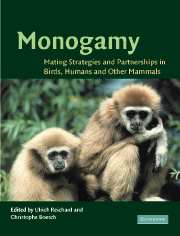Book contents
- Frontmatter
- Contents
- List of contributors
- Acknowledgements
- Introduction
- PART I Evolution of social monogamy
- PART II Reproductive strategies of socially monogamous males and females
- PART III Reproductive strategies of human and non-human primates
- CHAPTER 11 Ecological and social complexities in human monogamy
- CHAPTER 12 Social monogamy in a human society: marriage and reproductive success among the Dogon
- CHAPTER 13 Social monogamy in gibbons: the male perspective
- CHAPTER 14 Pair living and mating strategies in the fat-tailed dwarf lemur (Cheirogaleus medius)
- CHAPTER 15 Social monogamy and its variations in callitrichids: do these relate to the costs of infant care?
- CHAPTER 16 Monogamy in New World primates: what can patterns of olfactory communication tell us?
- Index
CHAPTER 16 - Monogamy in New World primates: what can patterns of olfactory communication tell us?
Published online by Cambridge University Press: 05 July 2014
- Frontmatter
- Contents
- List of contributors
- Acknowledgements
- Introduction
- PART I Evolution of social monogamy
- PART II Reproductive strategies of socially monogamous males and females
- PART III Reproductive strategies of human and non-human primates
- CHAPTER 11 Ecological and social complexities in human monogamy
- CHAPTER 12 Social monogamy in a human society: marriage and reproductive success among the Dogon
- CHAPTER 13 Social monogamy in gibbons: the male perspective
- CHAPTER 14 Pair living and mating strategies in the fat-tailed dwarf lemur (Cheirogaleus medius)
- CHAPTER 15 Social monogamy and its variations in callitrichids: do these relate to the costs of infant care?
- CHAPTER 16 Monogamy in New World primates: what can patterns of olfactory communication tell us?
- Index
Summary
INTRODUCTION
Social communication and social monogamy
Communication is an integral component of social processes and social evolution (Hahn & Simmel, 1974; Philips & Austad, 1990), and variation in social systems influences patterns of communication (Marler & Mitani, 1988). Amongst other functions, communication may serve to attract, stimulate, defend, or compete for mates, and thus is intimately related to social organization and mating systems (Hahn & Simmel, 1974; Johnstone, 1997). The intensity of signals and displays can serve as a cue to the quality of mates or opponents, and if interindividual variation of signal quality exists, sexual selection can act upon signals and displays through mate choice and intrasexual competition (Johnstone, 1995). Examples are visual and vocal displays in many mammals, birds, and other vertebrates (e.g., Clutton-Brock & Albon, 1979; Ryan, 1983; Hill, 1990). Since in most animals it is usually males who compete for females, and females who are choosy about males, sexual selection results in signals and displays being either exclusive to or exaggerated in males (Andersson, 1994). Nevertheless, mutual sexual selection can lead to signals being expressed to the same degree in both sexes (Jones & Hunter, 1993). This may be the case in monogamous animals, which are often monomorphic, both physically and behaviourally, including their communication patterns (Kleiman, 1977). Deviations from the behavioural monomorphism of signals and displays in socially monogamous animals can be expected if the selective forces driving males and females into a monogamous system differ between the sexes.
- Type
- Chapter
- Information
- MonogamyMating Strategies and Partnerships in Birds, Humans and Other Mammals, pp. 248 - 261Publisher: Cambridge University PressPrint publication year: 2003
- 7
- Cited by



